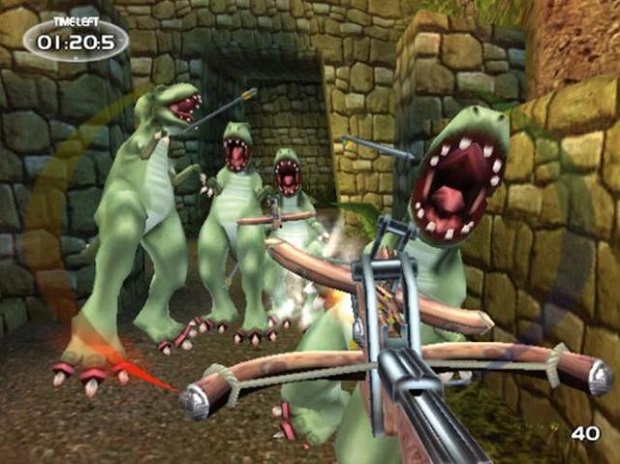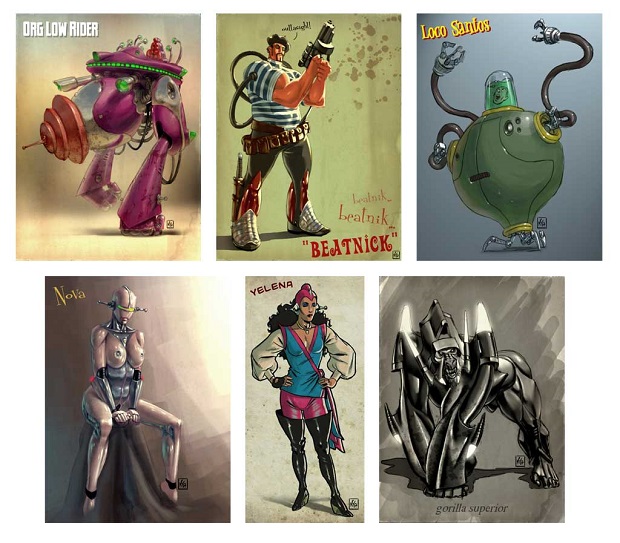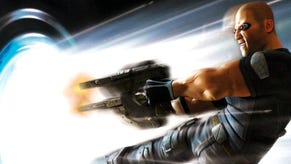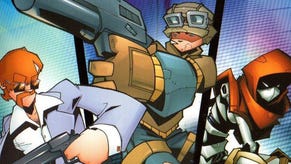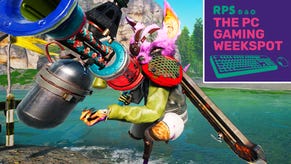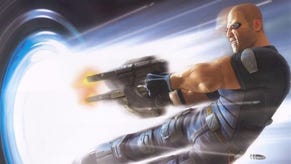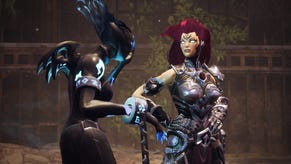A Bright Future: The Long Road To TimeSplitters Rewind
Back to the future
For some, TimeSplitters ranks with GoldenEye as one of the great multiplayer FPS games. To be more precise, it's one of the great multiplayer FPS games that never made it to PC. Created by Free Radical Design, a studio made up primarily of ex-Rare employees, the original TimeSplitters was a PS2 launch title. Two sequels followed but sales of the third game weren't strong enough for a fourth title to go into production.
For years now, a team of part-time developers have been working to bring the series back to life, on PC, as a free project using CryEngine 3, and assets from the originals, with the permission of IP holders Crytek. This is the story of TimeSplitters Rewind.
TimeSplitters 2 and its sequel, Future Perfect, were the last - and possibly the only - multiplayer shooters I truly loved. This is a long-harboured secret of mine, for which I feel I should apologise to subsequent shooters that I’ve encountered over the years. So I’m sorry to Battlefield 2, the first game that placed me in a shell-shockingly convincing theatre of war. I’m sorry to Killzone 2, whose Warzone was one of the most balanced, well-paced multiplayer modes I’ve ever played. And I’m sorry to Team Fortress 2 - your gameplay formula is timeless, but your kooky and irreverent style was blatantly inspired by TimeSplitters and I want you to admit it.
And to all the other multiplayer shooters that I’ve been involved with (you know who you are), I’m sorry, I’m sorry, I’m sorry.
The TimeSplitters series began life on the PS2. It was not as refined or technically impressive as any of the above-mentioned titles, being the last of an era of distinctly ‘consoley’ shooters made by Free Radical - a company of former Rare developers who were behind the great Goldeneye and Perfect Dark for the N64. Like its spiritual predecessors, TimeSplitters had generous auto-aim, no jumping, and gliding movement as if instead of feet everyone was moving around on giant roller-balls like that new R2-D2 thingy in that space movie. Unlike its contemporary, Halo, TimeSplitters contained no mechanics that really hinted at what the future of shooters would look like. The series effectively existed in a vacuum.
What made the games special was their blistering pace, incredibly malleable multiplayer, and a carefree character that the shooter genre had been bereft of since the glorious Build engine days. This was all complimented by a wacky sense of humour and haphazard presentation, creating a veritable FPS toybox in which monkeys and zombies and robots and gingerbread men could all happily co-exist - as in, shoot the shit out of each other - across a range of eccentrically themed environments.
I spent untold sleepless nights with a trio of my most esteemed buddies (you knew you were in there if I invited you to a TimeSplitters Night), blithely picking random combinations of modes, bots and maps with unexpected and brilliant results. There was Virus on Temple with an army of zombie-bots - essentially a ‘Family It’ mode that would lead to giddy last stands when it was just you and one other player left to fend off hordes of green-flamed infected. Or a Gladiator match in a Chinese restaurant, with shards of plate and glass sprinkling the screen like callous confetti as everyone tries to be the one to put the killing bullet into the overpowered, titular Gladiator in order to take their place and wreak havoc.
It all seemed so random, and yet when you combined these disparate modes, levels and freaky characters, it gelled together beautifully. A large-headed man in tighty-whiteys with his nipples in a harness gunning down zombies on a frozen lake? A deathmatch in which you grow bigger or smaller depending on how well or badly you’re performing? Circuses, Discos, Mexican Frontier Towns, Haunted Hotels and ‘Nam? Playable Lions and Tigers and Bears? Oh my, indeed.
TimeSplitters was a joyous fancy dress party of a shooter.
The party was to carry on into the seventh console generation, as TimeSplitters 4 for the PS3 and Xbox 360 entered development in 2009, but didn’t last long as Free Radical filed for bankruptcy before being bought out by Crytek to become Crytek UK. Looking at the low sales of TimeSplitters: Future Perfect, the publisher decided there was no more demand for light-hearted shooters of its ilk and shelved it.
Over the next few years, petitions for Crytek to make TimeSplitters 4 or an HD collection hit 50,000 and 90,000 signatures respectively, but to no avail. Eventually, the people behind those petitions took matters into their own hands. In 2013, with permission from Crytek to use the IP and assets of the original games, they set out to revive the cult shooter for the open, accommodating PC market as TimeSplitters Rewind - an entirely free game that would amalgamate the best bits of the series up to this point. Beyond being a labour of love, the fan project’s goal is to prove there’s room for its unique brand of silliness in today’s gaming scene, and for Crytek and other publishers to take note.
You can be forgiven for never having heard of Rewind. It doesn’t mean you’ve been living under the proverbial rock. In fact, if you were under the rock, there’s a good chance you’d have found TimeSplitters Rewind burrowed down there, its unpaid part-time dev team toiling away for the best part of three years in the sodden ground, and staying out of the limelight as they seek to revitalise the console cult classic in CryEngine 3.
It’s a massive undertaking, which the project’s community manager (slash level designer, slash several other things, as is so often the way with fan projects) Steven Williams, conveniently quantified for me: 42 unique levels, 273 unique characters, about 99 unique weapons, all built from the ground up, and only using the original assets for reference - and that’s saying nothing of the bot AI, game mechanics and online support. What AAA modern-day shooter has that much content, let alone a bloody fan project that stands to not make a penny?
It sounds mad, quixotic, like Fitzcarraldo pulling his steamboat over a mountain. Steven beats me to acknowledging this, in more understated terms: “It’s kind of crazy for us to even do this project, yet we love the series too much to not do it.” I ask why we’ve heard so little about the project over the past couple of years.
Early in TimeSplitters Rewind’s development, the project was making its presence felt in the media spotlight, culminating in September 2013 when it was unveiled that the game would be coming to PS4 as well as PC. The original project manager of Rewind was described by Steven as “interesting, charismatic, and bringing forth a lot of personality”. He waved the flag for the game to the press, promising PS4 vs PC crossplay, uploading plenty of artwork and assets online, and suggesting a playable demo of Rewind would be ready by December 2013.
The hype machine kicked into action, but it quickly outraced the pace at which the ever-shifting part-time dev team - currently 18 people, but with over 60 having come and gone over the years - felt comfortable working. It was all happening too fast. The team decided to part ways with their enthusiastic manager, and to take the project back underground, back beneath that rock I was prattling on about earlier. Since then, any coverage of it has been only within the self-contained realms of its Facebook and Twitter pages, and website. Even then, there’d sometimes be no updates for months at a time, only for new screenshots or a lovely video of a remastered level to suddenly pop up and reassure the adoring followers that the project is ticking along. According to Steven, this is just how the team wants it:
“I’d prefer that we don’t see articles every month asking ‘Where’s the project gone?’ It gives us breathing room to get things taken care of before we start unveiling actual gameplay. We’re happy to work without deadlines. Was it Douglas Adams who said, ‘I love deadlines. I love the whooshing sound they make as they go by’?”
With nothing to gain other than possible canonisation by the TimeSplitters community, media coverage becomes a risky - even unnecessary - strategy, putting pressures on the team without the eventual sales boosts that ostensibly justify them. Absolved of media intrusions (apart from my snoopy self), the team has been free to work on the game at their own pace.
But that doesn’t make the project some kind of utopian vision of game development. Rewind hasn’t had the modern-day privileges of Kickstarter or other crowdfunding because of the fact that it’s using a Crytek IP, so the only funding it’s received has been courtesy of the 250 or so donations via the inconspicuous ‘PayPal donation’ option on its website. Has the lack of these perks inhibited the project in any way? “It makes things tougher, but, man, money can complicate things as well,” said Steven. “If we crowdfunded it or asked people to pay when it goes into Early Access, different people have so many different ideas about what they want for their money at that point, that it can turn ugly.”
Over the past couple of years, the project has trickled out fly-by videos of TimeSplitters levels reimagined in the CryEngine, and richly detailed high-polygon artwork of the weapons and colourful characters that give the series its idiosyncratic personality. With the source material coming from an era of relatively undetailed polygonal graphics, there’s plenty of room for creative interpretation and evolution too, boring into the character models and levels in ways that weren’t possible 14 years ago. The goal is not only to recapture the spirit of the games as they were all those years ago, but to build on the ideas that inspired them.
To this end, the team has been in regular contact with former Free Radical developers - from the composers to the character artists and level designers. “These people are kind of like mentors for us,” said Steven. “It’s not like they’re telling us what we should or should not do, but it’s great to have their perspective - hearing about what their experiences of making the games were, and where they got their inspirations from when creating the levels.”
For example, one of Rewind’s level designers, Momotaro Ushido, learned from a TimeSplitters 2 coder that Aztec Ruins was inspired by Indiana Jones (as any self-respecting level involving jungles, temples and those stepped pyramids should be). It’s a mazey mix of booby traps, dead ends and ancient stone-pillar puzzles. But for Rewind, the team wants to exclaim those inspirations, realising that sense of adventure and energy in ways the original games couldn’t have dreamed of at the time. Ushido even received the sage advice to listen to the Indiana Jones soundtrack while working on the level. Below are screenshots of the original (complete with melon-hurling monkey) and an early screenshot of the Rewind version.
Castle is another map that takes cues from the uninhibited visions of Free Radical developers, using CryEngine 4 as a vehicle - or perhaps a pumpkin carriage - to sweep the aesthetic further off into the fantastical rather than reeling it in towards reality. In TimeSplitters 1, Castle was a pretty stern affair - a warren of cold, stoney corridors imbued with quirkiness only by way of the series’ trademark disco-like lighting scheme that ranges from base blues, to reds, to yellows across the level.
The designer behind the Castle remake, Sean Spencer, saw its shortcomings. "I felt that a one-to-one remaster would turn out too bland compared to the other maps in the lineup,” he said, looking instead to one of the few concepts shots for the doomed fourth entry in the series. “I adopted the TimeSplitters 4 Concept Art for the Steampunk Dracula segment, and played with it to get the new Castle." The result is the curvaceous, fairytale castle you see below.
Finally, Steven talks about Spaceways, the campy retro-futuristic airport, which he was told by its original designer was inspired by 90s sci-fi classic, The Fifth Element. You can see that in the original map, with its sunny oranges and browns, and fawny metallic corridors. For Steven, it’s one of those levels that’s so ripe for creative expansion, that it makes him “really want to drop everything else, start a block-out and get to work on some big props for it”. But he’s putting his visions of a futuristic city backdrop, complete with flying cars, to one side for now. “I and the others have other priorities before getting to those”.
In more ways than one, TimeSplitters is a better fit for today’s gaming scene than the comparatively gritty landscape that existed throughout the noughties. The last TimeSplitters game, Future Perfect, came out in 2005, the same year as Battlefield 2 and Call of Duty 2 - huge entries for both series that marked the meteoric (some would say cataclysmic) rise of the modern war shooter. The PS2 spin-offs of both games massively outsold TimeSplitters, indicating that audiences were too blown away by games’ newly discovered abilities to capture the intensity of ‘realistic’ warfare. After all, who had time for self-aware silliness in a game featuring a mode where monkeys come and help the person who’s losing in an online match? Gamers, it seemed, were far too mature for such twaddle.
11 years on, and the military dictatorship of modern war shooters is over, as the latest CoD and Battlefield trailers show that both series to have taken their formulas in diametrically opposed historical directions. Meanwhile, the garish Battleborn and vibrant Overwatch have just begun competing for the shooter crown - both games exhibiting bold breakfast-TV visuals and eccentric characters. Even the new Doom has a comic-book feel about it, defying the bleak horror sensibilities of its predecessor, with even its ultra-violent instakills being too quick and absurd to feel at all, errrr, close to the bone. Gamers, it seems, are ready to have some character and colour reinjected into their FPS lives.
I suggest to Steven that another industry trend working in Rewind’s favour is the acceptance of Early Access and staggered release structures as a norm. “Yeah, absolutely. Considering the project size that system works really well for us,” he said. “We can release an initial selection of multiplayer levels, listen to fans, take it onboard, then release further levels, slowly building up a community and generating more and more excitement for each release”. Steven estimates that the project is about 20% complete so far, but under the early access structure that won’t stop a playable version of the game from appearing soon.
Yet despite its various facets feeling fit for 2016, it’s worth remembering that TimeSplitters is an old-school console shooter at heart. While its easy-going looks will be perfectly en vogue, its simple, arcadey gameplay will remain decidedly retro (though calling the early noughties retro makes me feel old and anxious). It’s hard to gauge whether the modern gamer - used to XP-oriented shooters like Battlefield and CoD, or the MMO-inspired Destiny and The Division, or eSport shooters like Rainbow Six: Siege and Counter-Strike - will take to TimeSplitters, which has always been an outsider defying any gameplay blueprints this side of the millennium.
I like to think that TimeSplitters Rewind will be a roaring success, that the masses will finally show some long overdue love for the game and the series, and that Crytek will allow the devs to profit off it as Valve did with Black Mesa, before reviving the series for a fully-funded fourth outing. A TimeSplitters 4 by Crytek would be ‘Mission Complete’ for Steven and the Rewind team. “But not before we see this project through to the end”, he stipulated.
Will TimeSplitters Rewind be a roaring success? Cult indie classic? Under-appreciated gem like Tribes and, err, previous TimeSplitters games? It’s all more Future Unknown than Future Perfect (sorry), but to its credit, Rewind is a free game that at this stage looks anything but. At the very least, you can try it when the time comes. At the very most, you’ll fall in love and never let go, just like me.


